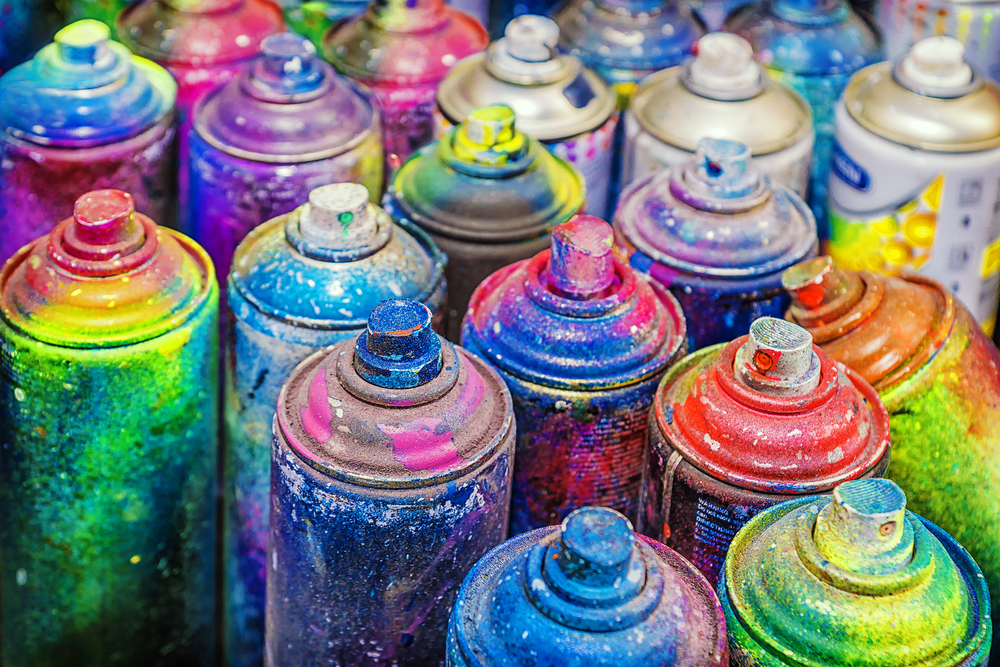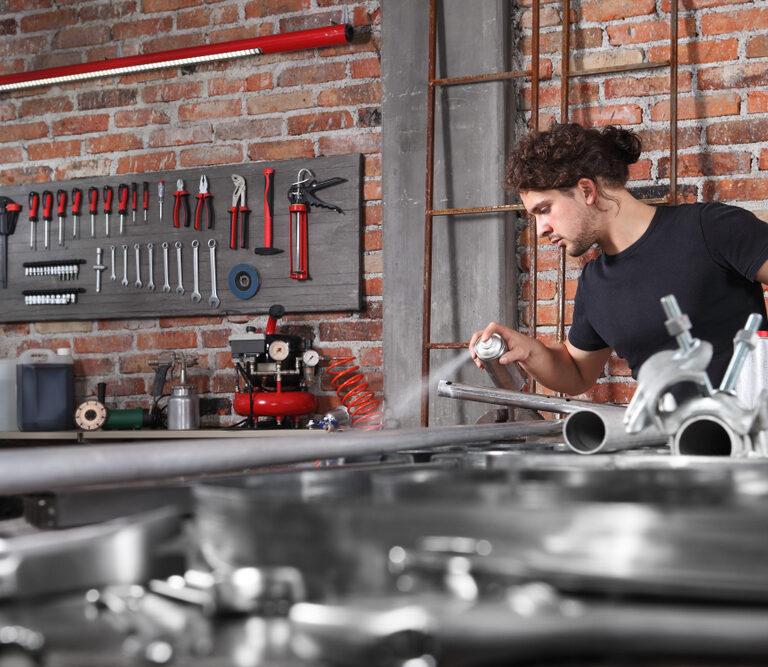In this article, we’ve brought you several useful top tips for spray painting metal, along with a foolproof step-by-step process for doing it. Even if you’ve never spray painted anything before, we’ve got your back. Though spray painting metal can be a surprisingly tricky task, we’ve made it easy for you.
Whatever metal you’re spray painting, this article will make it easy, stress-free ,and simple.
How to Spray Paint Metal
First up, our step-by-step guide. We’ll go into various pro-tips and answer a few common questions and concerns at the end of this article.
1) Get Your Paint Right
Certain spray paints are better for certain surfaces.
For spray painting metal, you should use enamel-based paints, which are usually rust-proof, hardy, and resilient in the face of cleaning and bad weather.
Not all spray paints are suitable for metal, so it’s important you buy paints which are. If you don’t, your spray job will be a massive waste of time.
If you’re unsure about what paints you should use, speak to someone at your local hardware store, who can recommend the right paint according to exactly what you’re painting.
2) Prep Your Surface
Here’s where lots of people fail on a metal spray painting job. Don’t skip this step, or you’ll fail too.
Preparing your surface is hugely important, and because metal doesn’t seem to like being spray painted, you’ve got to give it some encouragement.
Firstly, you need to scour your surface, to make your metal more adhesive. Get some sandpaper, a metal brush, steel wool or something similar, and lightly scratch and scour the entire surface you want to paint. If it’s lightly scratched, the paint will stick much more readily. The metal should look slightly scratched when you’re done.
When you’ve done all your scouring, it’s time to move onto some cleaning. You want your surface to be as clean as possible before you paint it, or else you’ll just be painting onto dirt and debris.
If there are any particularly dirty sections, use a warm, damp cloth to clean them down. You might even want to use rubbing alcohol. You also want to get rid of any and all rust, and make sure the metal is completely dry before you paint it.
3) Prep Your Painting Space
Before you start painting, make sure you’re doing it in an appropriate space. You’ll most likely want to work indoors (but more on that later), so make sure your space is properly ventilated.
Because spray painting is a messy job, it’s best to paint in a tool shed, garage, or something similar.
Cover all floors, surfaces and other unsuspecting sites of collateral damage.
If you’re painting something small, consider building a paint booth, which will stop your paint from getting everywhere.
If you’re painting something bigger, you could make a similar structure out of cardboard, plastic sheets, and construction plastic.
4) Painting Time
It’s time for your first coat of paint. Exciting!
A note here: if your paint doesn’t have primer in it, apply a coat of primer before you apply a coat of your proper paint. Don’t even think about skipping on the primer. But again, more on that later.
Here’s how to apply your paint:
Step 1.
Shake your can for around a minute, to get all that paint stirred up. Then give it a little squirt on a piece of card or paper, just to make sure it’s spraying properly and evenly.
Step 2.
When you’re ready to start, hold your can about 12 inches from the surface you’re painting. Spray lightly and evenly in a left-right or up-down sweep. Don’t keep going back and forth; stop when you’ve completed one “sweep.”
Step 3.
Keep doing lots of sweeps. Eventually, you’ll have one good, even coat across the whole thing you’re painting. Between each sweep, shake your can for 5 or 10 seconds, just to make sure your paint comes out smooth and even.
Step 4.
When you’ve finished one light, even coat, stop for a while. Have a coffee and wait for it to dry. This might take a little longer than you expect, since enamel spray paints are oil-based – and oil-based paints take a while to dry.
Step 5.
When it’s dry, you’ll need at least 1 or 2 more coats. When the paint from the first coat is 100% dry, add another coat. When that coat is 100% dry, add a third, if you think it needs it. Some surfaces might need up to 5 or 6 coats.
And that’s it! You can paint pretty much every metal surface using the method above.
But you don’t need to be limited by metal. If you’ve got yourself hooked on squirting spray paint on and around your home and everything you own, this video has some other home-based spray painting projects you might want to embark upon.
Pro-Tips for Spray Painting Metal

Before you follow the step-by-step process above, make sure you’ve read these handy hacks and tips:
- Always stay safe. Wear goggles, a mask, and gloves. You don’t want to get paint in or on your mouth, eyes or hands, and you don’t want to breathe in any fumes. Don’t skimp on safety.
- Before you start spraying your metal object, remove all fixtures (such as screws, nails and any other stuff). If you paint over screws, you might never be able to use them again (since they’ll be clogged up with paint).
- Do your spraying in the right place. If you do it somewhere wet or windy, your paint obviously isn’t gonna stick. Windy weather can blow paint around, and blow stuff onto your paint. That’s why it’s best to work indoors.
- Before you start working on the thing you want to spray, practice on some other piece of junk. That way, you can get used to how the can sprays and feels without ruining the thing you’re trying to improve.
- It’s best to paint in “sweeps,” as it’s important to keep your full arm (or body) moving as you spray. If you stop moving, you’ll create big ugly blobs of paint. If you do create these big blobs of paint, remove all excess paint as soon as you can.
- Measure the object you’re planning to spray, and buy your paint accordingly. An average 12oz can will paint around 8 square feet of stuff, or maybe a little more if you’re experienced (and therefore less wasteful).
- If you only want to paint some areas of your surface, masking tape is your friend. Use the tape to cover the places you don’t want to paint, then peel it off when your paint is dry. If you want something even more professional, try ScotchBlue Multi-Surface Painter’s Tape, instead.
- Don’t be tempted to replace several light coats with 1 heavy coat. It won’t look good, it won’t dry properly, and you’ll be left with lots of drips. If you’re patient, the resulting paint job will look way better.
- Try to avoid touching the metal with your bare hands. Hands have natural oils, and these natural oils will ruin your paintwork. As much as possible, move around whatever you’re painting, instead of moving it around you.
Do I Need to Use Primer With Spray Paint?
Yes, you should always buy paint that includes primer.
If your paint doesn’t include primer, you’ll have to do a priming spray first. If that’s the case, simply spray the primer just like you’d spray normal paint – but make sure the primer is absolutely dry before spraying your proper paint on top of it.
If you don’t use primer, your paint won’t properly stick to whatever you’re trying to paint (even if you do give it a good roughing up). If you don’t use primer, your paint is likely to peel away over time, leaving your painted thing even uglier than it was before.
Primer is also great for preventing rust, which is especially important for metal things that live outside.
Primer is cheap and useful, so don’t skimp on it.
It’s important to use a primer which is designed for spraying on metal, as not all of them are. We recommend this variety from Rust-Oleum.
Help! I’ve Got Spray Paint on Something I Didn’t Mean To! How Do I Get it Off?
First of all, don’t panic. Most of the time, it’s easy to remove paint from most surfaces. For hard surfaces, paint thinner and rubbing alcohol are the best options. They work best on wet paint, but they get the job done with dry paint too.
Don’t use these things on fabric. Instead, make a rub from half detergent and half water, and apply it to the stain. Leave it a while before removing it.
If you’ve got spray paint on your skin, nail varnish remover usually works. Another good solution is mixing dish soap with olive oil, before washing your hands as normal.
Final Thoughts
And there you have it, our definitive guide to spray painting metal. While it may seem straightforward, there’s a lot more to it than you might expect. We hope that our helpful, informative guide has provided you with the expertise you need to successfully accomplish this task.
